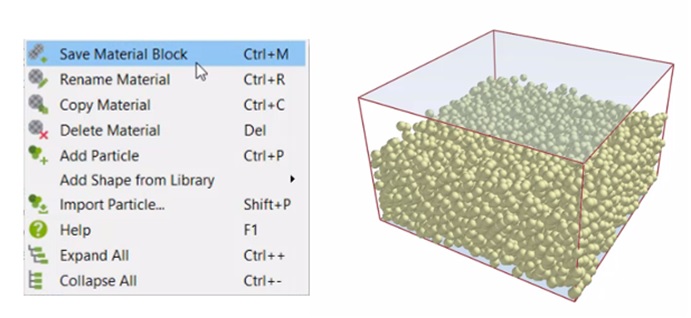Editor’s Pick: Automate Analysis of Complicated Discrete Loads
Altair EDEM 2020 discrete element analysis software is made for bulk and granular material simulation.

EDEM 2020 simplifies the process of creating and analyzing complex discrete loads. Image courtesy of Altair.
Latest News
December 17, 2019
Altair introduces EDEM 2020, the first update since acquisition of the discrete element analysis software for bulk and granular material simulation. Check out the video here.
Altair says improving speed and increasing the use of automated features have been the twin focus of this update. There are new tools to automate various setup procedures, and there is new support for GPU-based computation.
EDEM is used for virtual testing of equipment that handles or processes bulk materials in the mining, equipment manufacturing and process industries. Even before the Altair acquisition, companies worldwide were using EDEM to optimize equipment design.
EDEM can simulate any size and shape of material using the computationally efficient and well-validated multi-sphere method. In this method, shape is introduced by overlapping multiple spheres and, by increasing the number of overlapping spheres, it allows for increased shape fidelity.
With the new Sphere Fitting tool, users no longer must manually arrange spheres to create the shape they want to represent. The tool automatically builds a multi-sphere particle that closely matches an imported particle shape from a CAD file. Users can control the number of spheres used, as well as restrict the minimum sphere size. Altair says this tool allows users to benefit from efficient multi-sphere simulation without the effort of building the particle shape.

Previous versions of EDEM featured a bed generation feature, also known as material block, to generate large beds of material quickly. In EDEM 2020 this feature has been extended to operate as a “dynamic factory,” meaning the same block of material can be automatically introduced in a simulation at regular intervals. Altair says this works well where batching occurs naturally, such as with screw augers, belted conveyors, balers and more. This capability provides a way to enable the output of one simulation to be used as input to another simulation without having to rerun it.
A motion control capability is now available, enabling users to introduce motions to geometries that occur due to application of force or torque. Previously only possible via EDEM’s coupling interface, this capability to add force and torque is now available directly from the EDEM Creator and can be combined with regular kinematics.
Altair benchmarks show great speed-up when using GPU computation in EDEM 2020, as opposed to CPU only. Some standard examples show a speed-up of up to 15 times when using a high-end graphics processing unit (GPU) card versus 12 CPUs. The GPU solver is compatible with application programming interface models. The EDEM coupling interface enables all users to benefit from a speed-up regardless of how complex the simulation.
EDEMpy is a Python library for post-processing and analyzing EDEM simulation data, simplifying the process of extracting specific data from a simulation deck and processing that data in a customizable and reusable way. A range of enhancements in the latest version includes a new binning feature for searching objects inside a box or cylinder bin, new methods for getting sphere position and radii data, and improved performance for getting contacts and bonds data.
Coupling EDEM with multi-body dynamics (MBD) software enables engineers designing heavy equipment to introduce realistic bulk material in their MBD simulations and to get key insight into machine-material interaction. EDEM can now be coupled to Altair MotionSolve in addition to the range of solutions already available with other MBD software.
EDEM-Fluent coupling, enabling users to accurately simulate a variety of particle-fluid systems, has been updated and now allows users to transfer chemical-species data. This makes it possible to simulate complex thermal and chemical reactions such as evaporation, and in a subsequent update, it will also enable combustion. Altair says this technology opens the door to a new range of applications that rely on processes dependent upon the modeling of these phenomena.
Users wanting to perform coupled DEM-CFD simulations now have the choice to couple EDEM with Fluent or the open source software, OpenFOAM. The EDEM-OpenFOAM coupling overcomes one of the common limitations with DEM-CFD coupled simulations, namely that particles must be smaller in volume than the mesh cells they occupy. This allows engineers to simulate a wide range of application types previously not possible.
EDEM 2020 is now available for upgrade directly from Altair.
For more information, click here.
A free video course on using EDEM 2020 is available by clicking here.
Sources: Press materials received from the company and additional information gleaned from the company’s website.
More Altair Coverage
Subscribe to our FREE magazine, FREE email newsletters or both!
Latest News
About the Author
DE’s editors contribute news and new product announcements to Digital Engineering.
Press releases may be sent to them via [email protected].






